If I have a religion, it’s with nature.
Some ten plus years ago, I asked my mom about her belief in a god. I had just finished reading David Eagleman’s The Secret Lives of the Brain, and whatever shreds of the Christianity lay dormant from my youth, they were obliterated by the book. So I called my mom. She’s a wildlife biologist, but she also holds “God” close in her life. How? I wanted to know. How do you practice science professionally and believe in the lore? How can you square facing death every day, yet believe in a man rising from the dead?
“When you study and practice biology, it is so spectacular it’s hard to believe there isn’t a god.”
While she and I don’t align in religion, we do align in awe. Nature is where I have always felt connected. I often wonder how people from other cultures describe this connection, what richer language there is when land isn’t something to be conquered but to be respected. I feel as powerful as I do vulnerable when immersed in the outdoors. It offers me clarity of thought and crystallization of vision. I become a conduit for creativity, nearly immediately conjuring dialogue for whatever scene I’m writing as I weave between the trees.
Nature has always been in my life, but it wasn’t always the focus. My story with nature is the romantic comedy where it takes someone the whole movie to realize love was right in front of them. As a child, I spent my days in the pasture. As a teen, I put my bike in the trunk of my car to go ride in the park. In my 20s, when I needed to feel better, it was always nature: swimming to the buoys in the BVI, running along the East River in New York, riding my bike into the canyons outside Boulder. With nature, I always loved to catch up, I always felt better after, I always gushed to others about how restorative it was — until Ben asked me to move into his place in the Santa Monica Mountains.
My worries were common: I wouldn’t be able to walk to the grocery? I would have to drive home from bars? I would be so far from… everything? He assured me: if I tried it, my perspective would change. My worries would become reasons to stay. They would become the wonders I was missing.
Of course, he was right. Immersed in the treetops of Topanga, many things would change: how I approached my career, how I built friendships, and how I treated myself. The single pane windows kept us connected in sound, in temperature, in sun and in wind. We were surrounded by scrub jays, dark-eyed juncos, bobcats, coyotes, raccoons, and trees — so many trees. But there was one part of our home that was near lifeless, starved for affection and attention: the garden.
It was a tiered slope down to our house, suffering in agony from a seemingly endless drought and years of neglect, and our landlord asked us to revive it. Under the canopy of the oak, I stared at the remaining succulents, they as skeptical of me as I was worried about them. It was like they could tell: I was 29 and had never owned a single plant in my entire life. Not exactly what you’re hoping for in the human tasked with your survival.
What I lacked in knowledge I made up for in sheer panic. Give them ash! Give them compost! Prune them! Water them! Anthropomorphize them so their imminent death weighs heavy on your shoulders forcing you to prioritize their wellbeing over everything else! While I spent the first three years sweating, I spent the final three years reveling. We took dead soil that spent years eroding into piles against the house and turned it into a semi-thriving garden full of succulents the size of samoyeds and bigger. At the same time, the transformation outside was inspiring a transformation inside: I had become a plant person.
Plants in the kitchen, plants on the balcony, plants next to the bed, over the bed, around the bed. Plants were everywhere that plants could thrive in our house. But in a house of 600 sq ft with ceilings a woman shy of 5’5” could touch on her tiptoes, there was only so much room for plants to grow. There was only so much room for us to grow. When we started looking to buy our own home, its position in nature was the most important element to us. We were fine with a teardown, a yurt, a shed so long as it had southern exposure and backcountry access.
When we first saw the house we’re now in, driving by it in 2019 on our grand tour of “where do we want to live that we can also afford,” Ben lamented that it would never go on sale. It was the kind of house we never saw on the market — an actual cabin of big logs, stonework, and just rough enough around the edges to feel like a home. Maybe we couldn’t have our dream house, but we could dream a house into some form of it. By 2021, we’d put in an offer on a home on the other side of this tiny town, and it fell through when the sellers lost their own sweetheart deal. They were set on selling though, and they said to come see the house anyway. We could have a Right of First Refusal when they were ready. We drove the 14 hours, ready to envision their house as our future.
When we arrived, our realtor had a surprise for us: there were four other houses for us to see, none of them listed on the market. And one of them was the log cabin. When we walked in, we were overwhelmed. This cabin had been a bachelor pad for decades, but it had something in common with our treehouse near the coast: it was more outside than in.
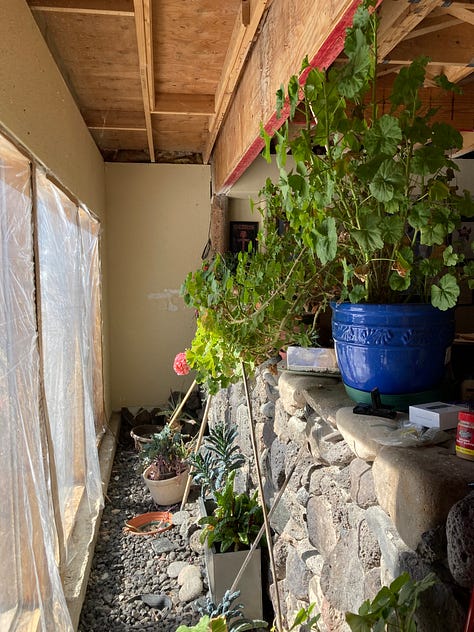
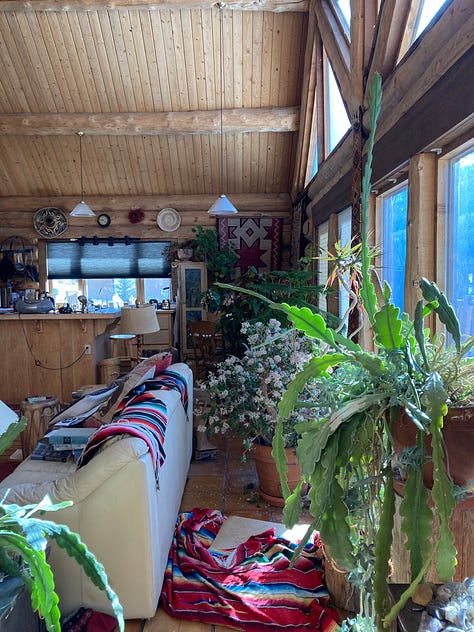
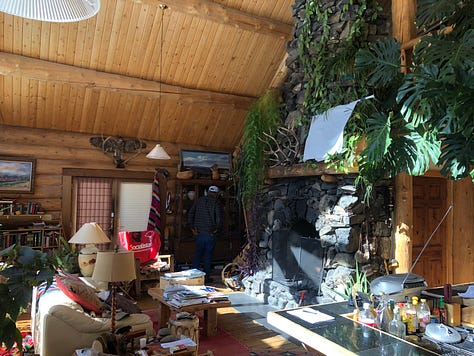
This man loved plants. And when it came to discussing if he was really ready to sell, he asked what we thought of the plants. He’d been growing many of them for over 20 years. These plants were in college, they were starting careers, they weren’t just in this house, they were part of it. What did we think of the plants?
We would spend our lives loving them.
The deal was done. On the condition that we care for his friends, we could buy the house. He took the ones he could, but some of them couldn’t be moved: the monster monstera, the philodendron tree, a few of the massive aloes, the spindly geraniums, the hoya carnosa climbing the fireplace, and all its friends draping down alongside it: the spider plant, the epiphyllum, and the asparagus adscendens.
His instructions were suspiciously simple: water all of them once a week. That was it. “You’ll figure out the rest,” he said.
You do not figure out plants, the same way you do not figure out people. But like our desire to truly know someone, you can strive to know a plant, to recognize its cycles and its needs. To learn what it yearns for and what it turns from.
When we committed to love those 10 or so massive plants, we somehow ended up with 30 more. Look, I don’t know what happened. I don’t know if plants beget more plants. I don’t know if owning our home made us feel like we could be responsible for more life. I don’t know if it’s the fact that we literally live among the logs of deadfall calling out to their brethren. But I do know that in the eight years since I was tasked with saving a plant, I’ve been summoned to save a lot of them.
When I was crafting away in the Spoak App my vision for this house, I called the style “tropicabin.” I wanted to live in a jungle, but my home was in an alpine meadow at 10,000 feet. So how do you allow a house to be of the mountains, but to feel like a portal to the tropics? Plants. Plants are how you do that.
Listening to the 99% Invisible episode Say Aloe to My Little Frond, I wondered about the trend of houseplants itself. To examine your own reverence for the signs of influence and aesthetics is uncomfortable. It’s like asking your partner to go to couple’s therapy when everything feels great. Why? Is something wrong? As if the examination itself is what leads to the collapse.
The episode, featuring
's , goes into the history of houseplants and how they are very much not a millennial whimsy. They’ve cycled through our homes since the Victorian era — then a symbol of travel and status, as well as a comfort to the oft-women tending them. They roared through the 1960s and 70s, draping over everything that could be draped upon. And their surge from the 2010s to now surely correlates to the rise in screens, but causation? No. They’ve been our friends the whole time. They’re just easier to acquire and care for than ever before with their own industry and accessories abound.The monstera deliciosa that commands this house was not a millennial passion project. It was propagated in the 90s by a man born in 1939. He’s a man of deep feeling and few words.
“What’s the story with the plants?”
“Ah, you know, just makes it… nicer.”
And it does. It would not take a deep commitment to religious practices nor a very deep google to call the former owner a heathen, despite his own close relationship with his god. But for what he lacked in legality, he made up for in care for the natural world. His advice to us as he carried his final things from the house was “don’t drink the water. Get it from the spring up the street. You’ll be sick for a while, but then you’ll never have a problem again.” He’s 84 now, still handsome, still spry, still stopping by for clippings of the fertility plant.
We haven’t tried the spring water, but we do treat the plants to something a little more natural – from thaw to freeze, we collect rainwater in two large barrels on either side of the house. This untreated water, carried in the sky, from as far as where these plants are from, nurtures them again and again. I try my best, but the more I learn, the more I worry. The water is meant to be lukewarm so as not to shock the roots, but you’re meant to water plants in the morning — our rainwater is still a shock to the hand before the high altitude sun warms it. Rainwater is better, but from October to April, much of that rain is snow and ice. So then we water from the faucet, controlling for temperature but not for nutrients. So then we fertilize but you’re only supposed to fertilize in the spring through summer for the majority of plants. For every thing you do right, you do something wrong.
This same unraveling is what once stole my faith. Now, I find it is what restores it. For all the ways you’re not supposed to care for plants, so many of ours continue to thrive. Not all, but those who did find themselves on the brink of death have been revived, and two more who withered are showing confidence in their triage. I’ve trimmed roots and repotted and mixed soil and concocted special elixirs and held these darlings in my hands, and I am closer than ever to understanding tender care.
Another trend that swirls along the axis of houseplants is witchcraft. Potions, after all, are rarely eye of newt and toe of frog. They’re lavender and columbine, hyacinth and fleabane. They’re plants. They’re a woman making tea. Witches were kneeling at the altar of nature, seeking the secrets within it, tending to plants and to creatures, hidden away in the shadows of the trees long before we called them witches.
As the agony of Snoots’s death began to evaporate off my cheeks, I was left with a pit where he now only curls in my dreams. Pits in any place are dangerous, either fenced off or filled in, lest something fall in that cannot get out. I’ve learned the false promise of fences, and so I sought something to fill it. I saw Catherine Andrews’s Practical Spirituality course, and I hesitated only when worrying how Ben would perceive it. I took a moment to rest in how deeply he loves me, and purchased the course knowing how deeply I needed to love myself.
Spirituality always rang truer for me than religion, never having been able to respect a man standing on a platform as much as a falcon resting on the wind. I sought the ethereal and it sought me. Science took as much as it gave me, but I kept my secrets: my ghosts and my astrology, my winks to the rabbits and my whistles to the birds. I never really saw the difference between horoscopes and sermons, each written by humans inspired by something other, their purpose only to inspire you to live and live well. But after years and years of growing up, of stocks and mortgages, inflation and hospital bills, I found myself untethered. Then Catherine’s course found me.
Catherine’s approach is a sort of “take from this what you will,” asking us to investigate our own lineages before adopting the practices of others. I researched the malocchio still spoken of on my Sicilian side. In grade school, during a physical with my doctor, he noted my third nipple saying, “they’d’ve burned you at the stake for that one.” There are many ways that young girls align themselves with witchcraft, but that did it for me. When we left, my mother told me of the malocchio for the first time, saying that that was absolutely what I gave that man.
On my father’s side, I am mostly Norwegian — home to the Norse gods and the seiðr. The Seidr was typically a woman, a seeress. She would wear gloves and a hat made from cat fur, and could transport herself to the body of animals. She sang to the spirits, fading between their realm and ours. I thought of my therapist. I asked her once if she thought I could try mushrooms. “Your tether to reality is so thin,” she said. “I’m afraid you won’t come back.”
I deferred on ingesting only to find myself nurturing. A simple weekly watering burgeoned into a practice, a ritual. And the more I delved into the practice, the more connected to it I felt. The benefits of plants spread far beyond trips and treats. Working with plants reduces your stress. Being in their presence can improve your concentration and focus. They can alleviate depression, reduce hospital stays, and make your work less miserable. And so we care for them.
Sunday is plant day here. The newsletter is out, work waits until Monday, and I can turn my attention to the leaves and stems, spines and spikes. We take turns watering the 40 plus plants, pruning and trimming, lifting and cleaning. “Which week did you water the snake plants?” “I’m moving this aloe to the bedroom, I think it’ll be happier there.” “Did you mist the fern?” We go through a series of devotionals, music playing to vibrate the plants with moving air, walking from room to room spritzing and turning. We look for signs of growth in them, blissfully unaware of the growth within.
“What else is a house of flourishing houseplants but an opportunity to narrativize growth?” -
Isn’t that what religion is? Ritual and reverence? Devotion on a schedule? Offerings and care? The work to be a better person for the world around you? As Catherine guides me through tarot, feng shui, energy, and astrology, I find that through them all, I am guided back to the living. Pulling the Queen of Wands surrounded by her plants and her cats. Swapping the aloe from the front hall with the snake plant from the bedroom only to find that this is the flow feng shui recommends. The urge to clear the energy of pain and transform it into the warmth of new life. Gazing into the Milky Way far, far beyond who we are and who we will ever be. If the animals are my joy, the plants are my anchors. They are the tether I was lacking.
We look to mimic them: in their seasonal rest, in their knowledge that parts of them are meant to wilt and die so other parts might grow, in their ability to turn toward the sun when the sun is what they need. And in the face of them dying, of the reality that our presence here on this Earth has done them immeasurable harm, we seek to repent, to repair and repay.
On Sundays, I go to church. I fill the watering can, I dissolve the fertilizer, I dance and sing to the hymns of Dolly and Louis Prima with shears in one pocket and gnat traps in the other. I take care of them, and in return, they take care of me.
There are of course many ways to experience G’d, but for me the presence of the Divine on this Earth feels the most natural. It’s during this month where we start to see buds on trees and little bits of green popping up through the ground that we realize that we were never alone. Sometimes we don’t need a miracle, we just need a glimpse, a wink, or a feeling of connection to propel us forward. -
in Increasing JoyFor more things on plants that I’ve been loving:
Everything Summer Rayne Oakes (with a name like summer rain oaks what else was she gonna do but be a plant goddess?)
Magnolia Workshops: Caring for Common Houseplants with Hilton Carter on Discovery+
's pieces last year on the phenomenon:I also recommend searching for “british gardening shows” on YouTube. My favorite is the one with the hot brothers.
Lastly, below is a peek at the guide I’m building for Shangrilogs. Feel free to copy for your own purposes. I have a lot of research left to do. Bibles, as it were, take a lot of work.
Meet all the plants in The Shangrilogs Plant Guide. As we head toward Spring, I’ll be doing more updates on the plants as we work toward propagating, repotting, and supporting everyone’s blooms. And if you see a plant misidentified in the guide, be sure to let me know. I’m not an expert. Just an acolyte.


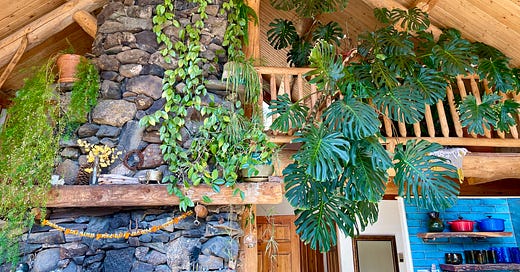


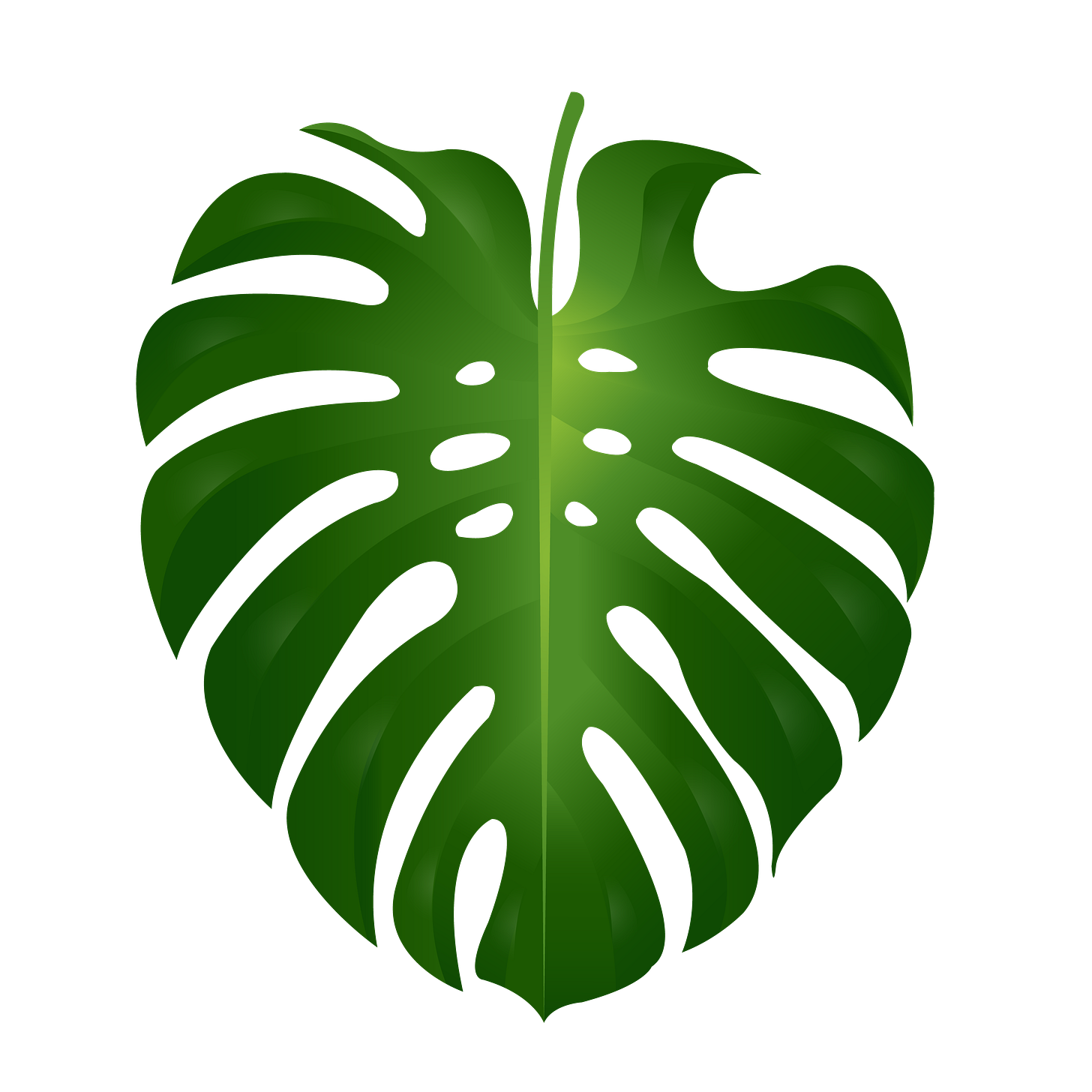
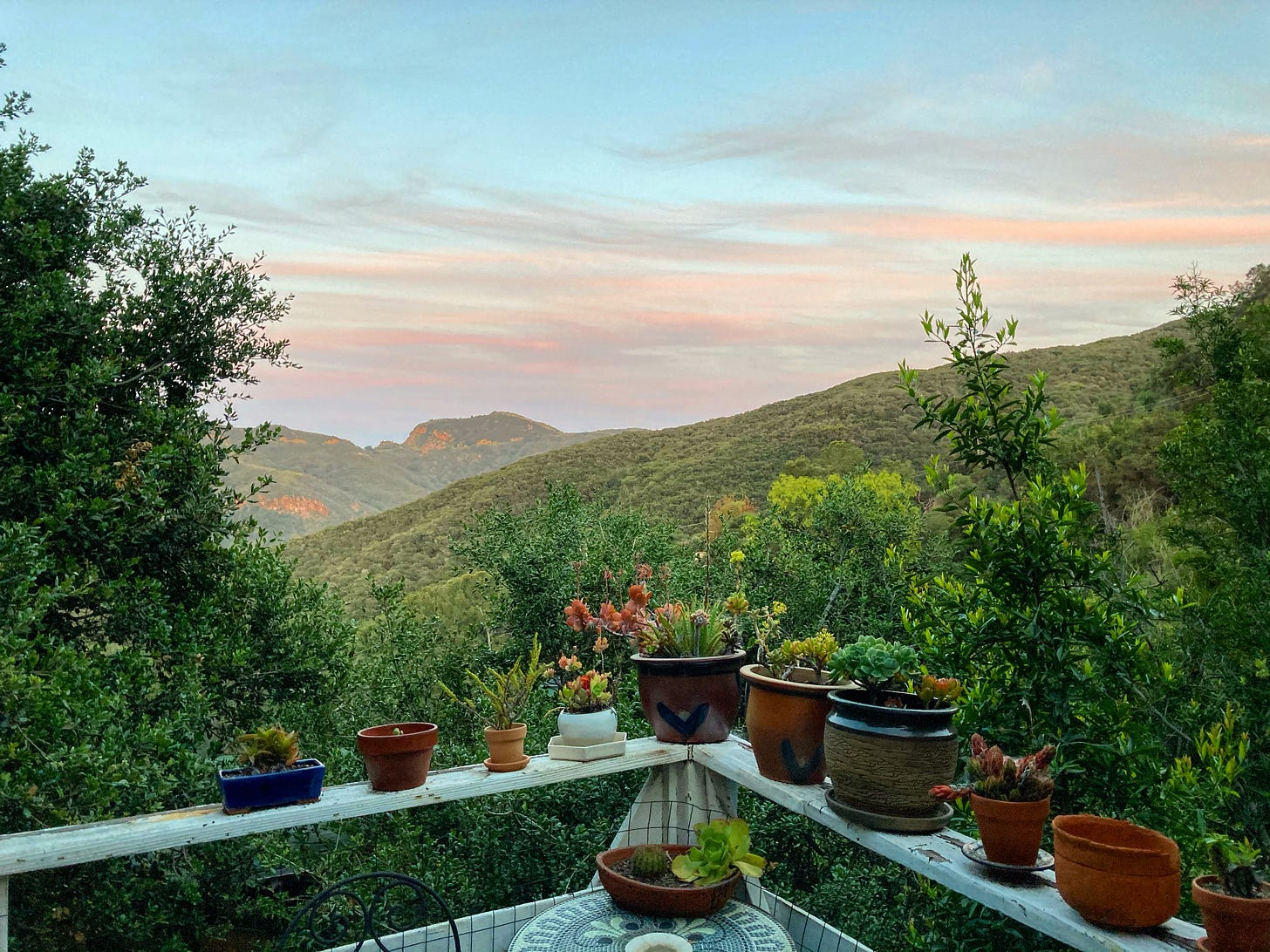


Speaking of the witchy-- I’m about halfway through The Very Secret Society of the Irregular Witches that was recommended in your weekday post. It’s yummy. Muchas gracias. 😊
My favorite post so far since becoming a subscriber!
Living in a tropical environment, I keep no house plants now other than an orchid or two before they go out to live on a tree. On the property that came into my care 18 months ago I have mainly removed about 50 neglected and inappropriate trees. The land has come into different life with the sun reaching it again. Feral pigs have come out of the macadamia nut orchard to dig and roll and tear up most of the "lawn" around the house and I think why mow an acre or two anyway? That's obviously the witch in me. I'm watching, waiting, tending pots with everything from roses and rosemary to kalo and a'ali'i.
And this phrase: "I never really saw the difference between horoscopes and sermons" made me want to holler "EXACTLY!"